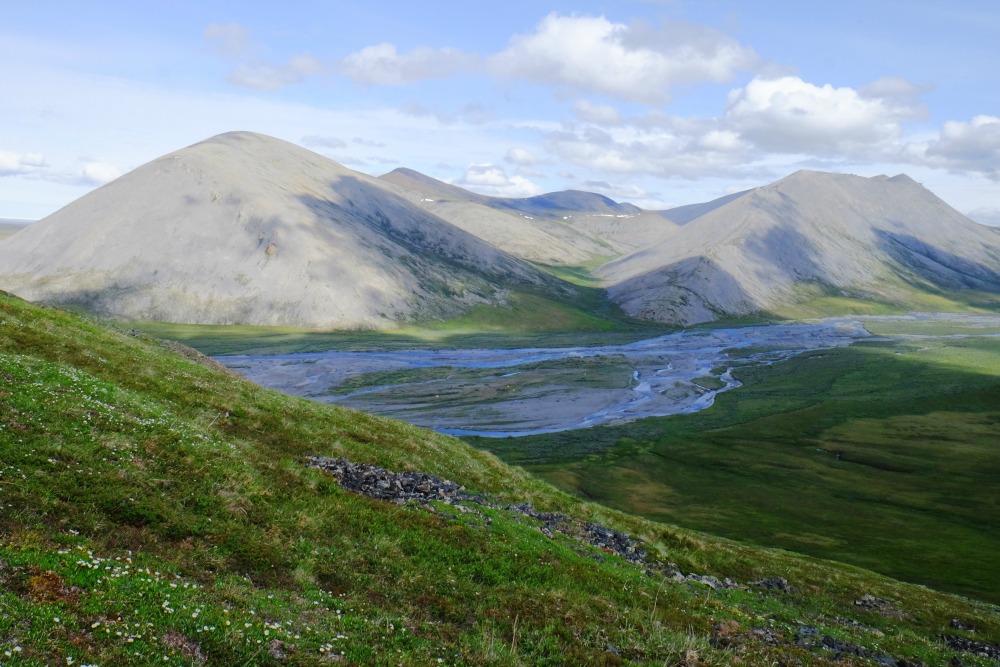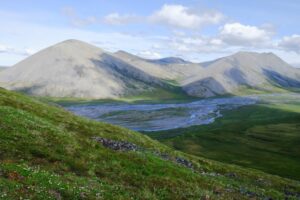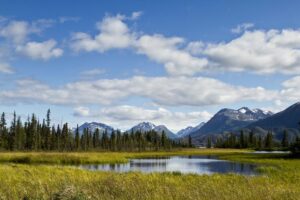
The law under fire—what does NEPA do?
By Dawnell Smith
Decades ago, bulldozers plowed interstate highways across the country without concern for the impacts on local communities. Unfettered industrialization and growth devasted waterways and landscapes and brought toxic pollution with it.
By the time the infamous “river on fire” made the cover of Time magazine in 1969, oil spills on the Cuyahoga River had already burned a dozen times. People witnessed those spills and fires. They could literally see the toxic air they breathed. They knew they had to do something.

Aichilik River Valley in the Arctic National Wildlife Refuge. Photo courtesy of James Spitzer.
Many of the bedrock environmental laws we know today were formed in those years. These laws compelled government to evaluate and address environmental consequences and community harm before making decisions about highways, infrastructure, and permit applications for industrial proposals. These laws can’t stop toxic waste, oil spills, air pollution, and other industrial impacts entirely—impacts often felt most by communities next to industrialization—but they did require that government to assess environmental impacts and provide a mechanism for accountability.
One of those laws, the National Environmental Policy Act, or NEPA, established policy and goals for the protection of the environment.
NEPA is under attack right now. The Trump administration intends to make NEPA a thing of the past. A January 2025 executive order aims to turn binding instructions for complying with the law to mere guidelines and states, “all agencies must prioritize efficiency and certainty over any other objectives.”
Here, a skewed notion of “efficiency” is prioritized before the fundamental purpose of NEPA—to consider and protect the environment. Here, the administration asserts a pervasive and careless disregard for land and water and indeed of health and life.
They do not care if the nation at large goes back to a time when oil-stained rivers burned, and bulldozers plowed through communities, and the air we breathe seethed with toxins, and lakes became acidic and inhospitable to fish, and no one was held accountable.
They don’t care, but we do.
What does NEPA do?
NEPA requires the federal government to assess the environmental impact of major projects requiring a final agency action (e.g., a permit) before making decisions or taking actions on them. It further establishes a broad national framework for accomplishing that goal. It’s common sense, really, to consider the consequences before doing something.
The law further ensures that federal permitting includes public input, transparency, and science-based decision-making. It applies to agency decisions and actions concerning federal land management and proposed projects like airports, military complexes, highways, public facilities, and permit applications for mining or oil and gas extraction.
A 1977 order signed by President Jimmy Carter authorized the White House Council on Environmental Quality, or CEQ, to issue binding instructions to agencies about how to comply with NEPA and do so consistently across agencies.

Hidden Creek in the Kenai Refuge. Photo by USFWS.
Importantly, those regulations require federal agencies to complete an environmental impact statement or environmental assessment when considering and making decisions about permit applications, or determining how an agency can meet NEPA requirements unless an action qualifies for a “categorical exclusion.”
These assessment processes ensure that people have a voice and that decisions are accountable to the law and the public.
The Trump executive order calling for the rescission of these NEPA regulations will turn them into guidelines applied inconsistently across agencies with environmental—and therefore human—considerations pared down to a legal minimum.
Alaska communities near oil and gas complexes, mining operations, and other industrialized areas already endure significant water and air pollution, destruction of the land and water around them, diminished hunting and fishing grounds, and the erosion, floods, sea ice reduction, permafrost thaw and severe storms caused by climate change.
Gutting NEPA will mean making what most Alaskans love about the lands around them much, much harder to protect.
The role of NEPA in our work
Our legal work engages heavily in agency environmental reviews and assessments, where we both submit substantial comments on behalf of clients and introduce important research and technical knowledge. Environmental reviews and assessments also come into play when we look at whether agencies complied with NEPA and other laws when making decisions.
In other words, environmental impact statements and assessments provide consistent systems for allowing local communities, scientists, stakeholders and the public to express concerns on the record and assess whether those concerns were addressed in the decisions agencies make.

Clouds and ice on the Chukchi sea. Photo courtesy of USFWS.
Back in 2014, 32 law professors deftly reiterated the importance of NEPA in a letter regarding the supplemental environmental impact statement for an oil and gas lease sale in the Chukchi Sea.
“…NEPA plays an important role in ensuring the orderly development of the nation’s oil and gas resources and in calling attention to the risks of environmental harm that accompany such development. NEPA is intended to ensure that federal agencies take environmental considerations into account before making final decisions.”
These professors go on to say that “it is essential for an environmental analysis prepared under NEPA to be completed before the agency makes its final decision and from an unhindered pre-decisional perspective.” The idea here is that decision-makers need to know and consider environmental effects before they make decisions.
Congress enacted NEPA the year after the 1969 Santa Barbara offshore well blowout and oil spill. At the time, that spill was the worst in U.S. history. It resulted from a federal regulator approving Union Oil’s request to waive safety requirements. California Congressman John Tunney described that decision and the ensuing spill as a manifestation of “centuries of careless neglect of the environment.”
The outrage over the loss of thousands and thousands of birds and marine life, the staining of the vast and vital coastline, and oil gushing over acres of ocean floor drew visibility and support for NEPA. President Nixon signed it into law in 1970.
A law in and of itself cannot stop agency or industry heads from making bad or reckless decisions, skirting regulations, and taking shortcuts, but it does give us a means to compel transparency and hold them accountable.
When we go to court to call out illegal agency actions and decisions, we aim to prevent harm and the worst and most devastating outcomes. The laws work like tools that give us the means to accountability—and the current effort to weaken or erase those laws aims to weaken and erase the mechanisms for accountability.
The goal? To allow industry and people with the means to remain lawless without consequences while shifting the consequences to the rest of us.
The law on fire

Caribou in the western Arctic. Photo courtesy of Florian Schulz.
The Trump administration has made no secret about wanting to gut environmental laws in the name of speeding up permit approvals for huge projects with life and death consequences.
A final rule came out in February that proposes rescinding NEPA regulations. The public comment period ends March 27.
If it goes through, it could mean that agencies limit public comment and make it hard for people to know what’s going on with a project or how to voice their views. I could mean agencies inconsistently apply NEPA. It will mean more chaos, less transparency, and weaker analysis of harm and outcomes on communities, landscapes, and climate health.
Right now, we all need to stand up for laws that are meant to protect the health of land, water, people and animals for generations to come, and to fight for the rule of law that holds people accountable to them.


